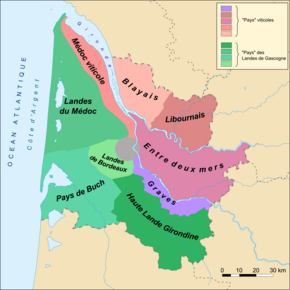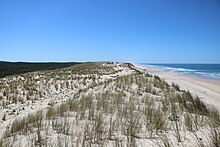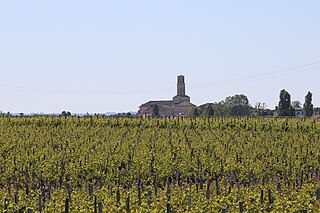Médoc
| Médoc | ||
 Medoc area in the north-west of the Gironde department |
||
| Geographical location | ||
|
|
||
| Coordinates | 45 ° 0 ′ 0 ″ N , 1 ° 0 ′ 0 ″ W | |
| Waters 1 | Bay of Biscay ( Atlantic Ocean ) | |
| Waters 2 | Gironde | |
The Médoc is a triangular peninsula in the Gironde département in southwestern France , which lies between the Atlantic coast ( Côte d'Argent ) on the Biscay , the Gironde estuary and the Arcachon sea basin .
The corner points of the peninsula are the city of Bordeaux in the southeast, Lège-Cap-Ferret on the Arcachon basin in the south, and in the north the headland of Pointe de Grave near Le Verdon .
landscape

Until about one hundred and fifty years ago, on the sea side of the peninsula there was barren undergrowth and grass vegetation on a distinctive dune landscape. Then pine forests were planted to drain the swampy land and curb the flight of sand. When they are fully grown, the pines withdraw around 80 liters of water per day from the soil. In dry times, however, the forests are also at risk of catching fire. Around 1990 a huge forest area burned down near Lacanau and was then completely reforested. Large firebreaks were then drawn through the forests throughout the region in order to prevent this catastrophe from happening again in the future.
Two of the largest inland lakes in France lie directly behind the dunes: the Hourtin-Carcans and Lacanau lakes , which extend parallel to the nearby Atlantic coast. There are sandy beaches in both places, which are mainly used by tourists in summer. In the pine forests there is usually no continuous coastal road connection. The coast can only be reached on access roads through the pine forests. Bicycle paths now lead from Le Verdon to the Arcachon Basin, and these often run independently of roads through forests and across the country.

Its location on the peninsula creates the remarkable situation that all waters in the hinterland flow either into the Gironde or into the Bassin d'Arcachon. Since coastal precipitation seeps away through the sand, a practically uninterrupted sandy beach has formed from the headland at the Pointe de Grave to the tip of Cap Ferret - with almost 100 kilometers one of the longest in Europe. The highest dune in Europe, the Dune du Pilat , a shifting dune 500 m wide, almost 3 km long and a height of 110 m, is located in the immediate south of the Médoc peninsula south of Arcachon .
On the land side, the vegetation is partly interspersed with mixed forests and otherwise barely structured. In addition to the pines, various types of oak grow there, including " arbousier ", which are bushes that can get very tall and which in autumn also bear prickly red, strawberry-like fruits and small white flowers.
The Médoc wine-growing region stretches along the left bank of the Gironde , a low-lying, gently sloping landscape with sedimentary subsoil (gravel and gravel), which is ideally suited for viticulture due to its permeability. The best locations are those that “see the water”, i. H. lie within the special microclimate created by the Gironde: The light is reflected by the large water surface and heat is stored, so that the conditions for the grapes to ripen are optimal. As the widest estuary in Europe, the Gironde is a rich fishing ground. The individual species vary depending on the salinity of the surrounding water. The Gironde is on the migratory route of many migratory birds and is the preferred breeding and resting place for many bird species. As this area is of great ecological interest, it was declared a national nature reserve in 2015.
tourism
Due to the poor transport connections, this coast is still quiet and relaxing for holiday purposes, despite increasing popularity. Campsites and holiday home settlements in particular open up the coast for holiday purposes. The whole coast is a paradise for surfers and windsurfers. Large naturist campsites can be found in Grayan-et-l'Hôpital ( Euronat ) and Montalivet-les-Bains ( CHM ).
The construction of houses with more than two storeys is prohibited on the entire Atlantic coast of the Médoc Peninsula. In Lacanau , however, this ban was circumvented. The local seven-story houses on the beach dunes caused the southern sand to migrate due to the influence of the wind, which means that houses are now threatened with silting up . But also in Soulac-sur-Mer there are buildings on the beach with several floors. For some time now, at least in Soulac, new buildings have been erected almost exclusively in the local style of spa architecture from the beginning of the 20th century, so as not to destroy the architectural unity of the city center. The tourist office offers guided walks, during which you can experience the historical core of the city of Soulac and, above all, its multitude of architectural gems from the past century.
The Cordouan lighthouse in Le Verdon-sur-Mer is the most famous lighthouse in the Médoc. It has been in operation since 1611, making it the longest-serving lighthouse in France. Its light crosses that of the lighthouses La Coubre (on the right bank) and Grave (on the Pointe de Grave). Other lighthouses mark the estuary: the lighthouses of Richard, Patiras and Trompeloup.
Viticulture
In the eastern part of the peninsula, settlement, agriculture and, above all, viticulture have long been to be found: The Médoc is also one of the most famous wine-growing regions on earth. The barren soil of the terminal moraines from the glaciation of the Pyrenees - Ice Ages offers the best conditions for the most widely used grape varieties Cabernet Sauvignon and Merlot . The wine-growing area extends over a length of 80 km and a maximum width of 10 km. The area planted with vines is 15,950 hectares. This area is divided as follows:
- Médoc is a sub-regional wine-growing appellation in the Bordeaux region . The appellation applies to the entire Médoc, but is actually only used for the northern part of the peninsula. Here, the proportion of Merlot is usually higher than in the other parts of the Médoc, so that the wines are somewhat fruity and have a rounder taste. The area of the vineyards is 5300 hectares, about 37 million bottles come from 127 Crus Bourgeois , 113 Crus Artisans, and 5 Caves Coopératives .
- Haut-Médoc , the second largest appellation, covers the southern part of the Médoc. Since the Haut-Médoc has 5 Grand Cru varieties, the reputation of this region is very good. The famous Crus often show strength and solidity with more prominent Cabernet Sauvignon, mostly intense aromas and, after a few years of aging, a complex bouquet and balance. The area of the vineyards is 4600 hectares, about 30 million bottles from 5 Crus Classés, 140 Crus Bourgeois, 116 Crus Artisans and other Crus, and 5 Caves Coopératives.
The wines of the six communal appellations (ordered upstream) enjoy the best reputation:
- Saint-Estèphe , they are known for their distinctive but classy tannins, which, in combination with the often more present acidity of the wines, guarantee a long aging. Then they show a characterful, often earthy note. The area of the vineyards is 1250 hectares, around 8.3 million bottles from 5 Crus Classés, 42 Crus Bourgeois, 25 Crus Artisans, other Crus and a Cave Coopérative.
- Pauillac , wines of power and structure that have powerful tannins and age excellently, only to reveal their second trait: elegance rich in finesse. The area of the vineyards is 1190 hectares, about 8.1 million bottles from 18 Crus Classés, 16 Crus Bourgeois, 7 Crus Artisans, other Crus and a Cave Coopérative.
- Saint-Julien , a lot of harmony and finesse, both in the bouquet and on the palate, with firm tannins and a good structure, which often give high potential. The area of the vineyards is 910 hectares, around 6 million bottles from 11 Crus Classés, 8 Crus Bourgeois and u. a. 11 Crus Artisans.
- Listrac , these wines, which are often quite closed when they are young, are solid and rich in tannins, but their usually relatively high Merlot content gives them a full and velvety character when they are mature. The area of the vineyards is 690 hectares, about 4.8 million bottles from 29 Crus Bourgeois , 12 Crus Artisans, other Crus and a Cave Coopérative.
- Moulis , the wines from Moulis are as varied as the soils, with a broad spectrum ranging from soft to full and more tannin-accentuated plants - with their peak after a decade. The area of the vineyards is 600 hectares, about 4 million areas from 31 Crus Bourgeois, 13 Crus Artisans and other Crus.
- Margaux , elegance is the key word for Margaux; Combined with attractive fruit in youth, the fine tannins withstand long aging in order to lead to gorgeous refinement in the largest. The area of the vineyards is 1410 hectares, around 9 million bottles from 21 Crus Classés, 25 Crus Bourgeois, 38 Crus Artisans and other Crus.
economy
In economic terms, besides tourism and viticulture, the timber industry , fishing and oyster farming in the Arcachon basin should be mentioned.
There are several refineries upstream of the city of Bordeaux in the area where the Dordogne converges, one of which is in Pauillac, and there is also a nuclear power plant on the right side of the Gironde. In addition to the port of the city of Bordeaux, the port of the small town of Pauillac and the container port and sailing port Port Médoc in Le Verdon at the mouth of the Gironde should also be mentioned.
traffic
The Médoc peninsula can be navigated from the south side via the land connection from Bordeaux. An expressway to Cap Ferret is connected to the ring road around Bordeaux, which roughly marks the geographical southern border of the peninsula.
Ferry connections run from Royan to Pointe de Grave near Le Verdon, about 12 km north of Soulac, and halfway up the east coast of the Gironde from Blaye to Port Lamarque. The holiday resort of Cap Ferret is connected to Arcachon by a passenger ferry across the Arcachon basin.
The Bordeaux-Merignac Airport in the west of the city lies at the southern foot of the Médoc peninsula.
A railway line runs from Bordeaux via Pauillac, Lesparre and Soulac to the Pointe de Grave.




